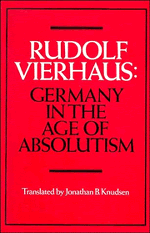Preface
Published online by Cambridge University Press: 05 June 2012
Summary
DIMENSIONS AND CHARACTER OF THE AGE
Germany in the Age of Absolutism – the title appears problematic in almost all its terms. It is difficult to ascertain what constituted “Germany” in the seventeenth and eighteenth centuries. For European diplomats and German imperial jurists it was undoubtedly the empire that still was called Roman; and many contemporaries agreed with them. Yet the empire encompassed many non-German peoples – especially in the lands of the House of Habsburg in the northwest, south, and southeast. In addition, Germans were excluded in the north and northeast. Moreover, certain Germanspeaking areas had once belonged to the empire and had since become independent or seceded, such as the northern Netherlands, Switzerland, and Alsatia. There was no German capital city; no common foreign policy affecting all Germans; and very little common history, but rather boundless local, regional, confessional, and cultural variation. Hence we cannot delimit precisely in geographical and political terms what belongs to German history in the period before us.
To accept this point, however, only means to be even more aware that the histories of the individual European peoples, states, and nations cannot be viewed or understood in isolation. If we still seek to write German history – even though Europe and its particular regions have both become much more sharply the focus of historical interest in recent decades – we must also integrate the gains of these two perspectives into our account.
Information
- Type
- Chapter
- Information
- Germany in the Age of Absolutism , pp. vii - viiiPublisher: Cambridge University PressPrint publication year: 1989
